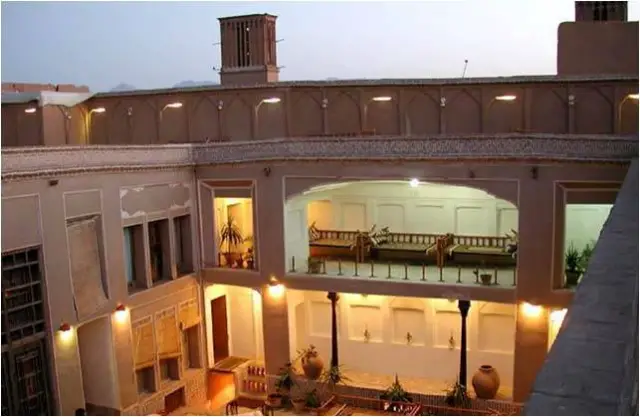
Traditional House in Yazd City, Iran
SPECIAL LOCATION
- It is not possible to talk about YAZDI traditional house with out considering the very special location of the city and its weather, so a brief information about the location and weather would help to understand the design of these houses much better.
Site Location
- Yazd City
- The city of Yazd is located in the eastern part of central Iran.
- Situated on the high, desert platform and due to its distance from important capital and its harsh natural surrounding.
- Yazd remained immune to major troop’s movement and destruction from wars.
- Therefore it kept many of its traditions, city form and architecture until recent time.
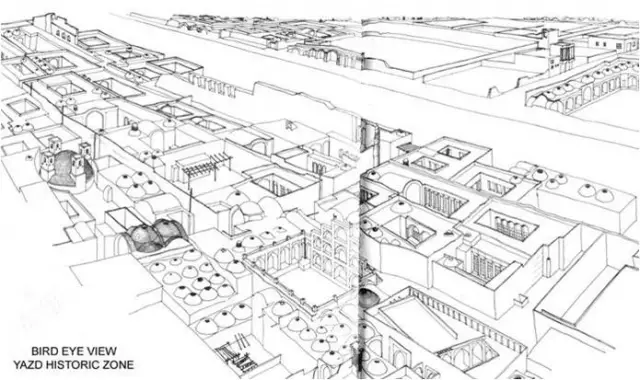
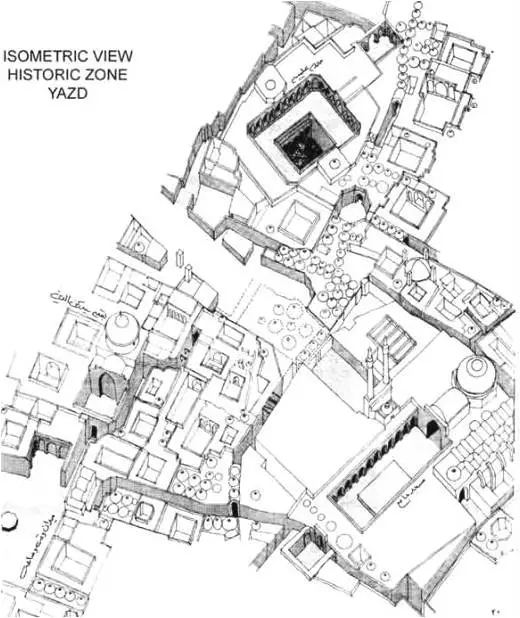
CLIMATE
- In Yazd climate plays the most important role in designing houses.
- As it maintained before, the city is placed in the central Iranian desert.
- So it’s obvious that the city has scorching hot and dry summers and very cold winters.
- The maximum temperature is 45.
- The lowest is –16.
- Designing of houses in this area is based on the climatic factors.
SPACES – ACTIVITIES
- Most of the old houses in this city are facing the holy kaaba.
- This house is also situated towards the holy kaaba (south-west).
- Entrance of the house is through narrow and covered lane.
- Most of the streets in the town are facing wind direction and they are narrower than those in other regions.
- And the covered lanes prevent the very high temperature of the sunlight.
- Facade of a house represents the social status of the owner of the house (which in this case, the facade carries tile work and quranic verses.)
- To enter into a house, one has to sound the knockers on its door.
- There are two knockers on the door, each of which, given its sound, is meant for ladies and gents.
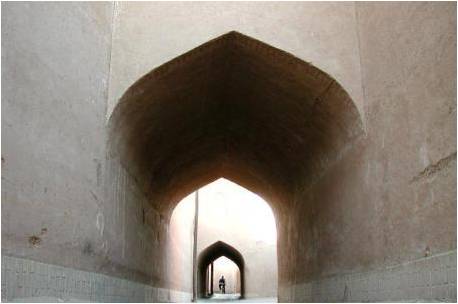
An alley in the old town of Yazd.
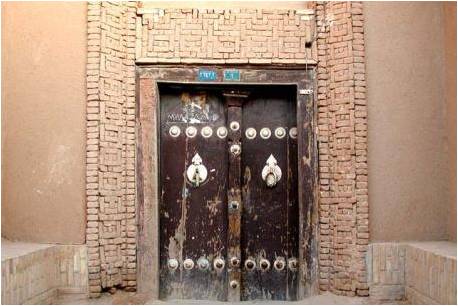
An old Iranian door. Men used the right doorknocker and women the left.
- After entrance, the level changes and octagonal spaces with a beautifully decorated ceiling appear.
- Then comes a number of stairs, leading to another octagonal space after which entrance to the yard is possible.
- Direct entrance into the house is not possible.
- Maintenance of modesty and security of the house is an Islamic principle.
- Thus, any new comer cannot see the entire of the house at one look.
- Also, the relatively long distance from door to yard provides enough time for the family members to go into their rooms.
- This octagonal space also serves like a waiting room.
- The most important complex of the house is situated at the Southeast portion.
- At the center of the front there is a five-door saloon with two small spaces attached to it.
- This saloon carries mirror work and, in fact, is a guesthouse.
- There is an independent entrance to this portion before reaching the yard.
- The guesthouse in Yazd, is a sign of respecting the guest and in the rich families, given the occupation of the owner.
- There is an independent place or yard allocated for the guests.
- At the two sides of the covered space there are two rooms whose windows open towards this space (the rooms are facing the space).
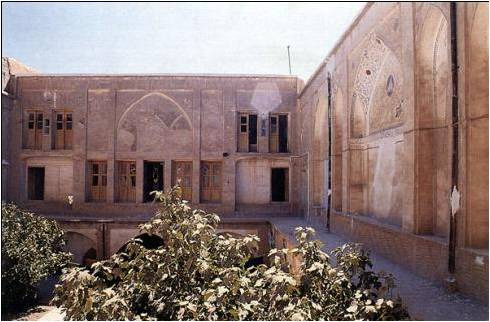
- The Northwest portion includes three Orsy rooms, with Shoe Keeping Space amongst them.
- These rooms were having Orsy doors (the doors moved vertically) with colorful glasses.
- These rooms, looking like huge saloons, are meant for spending summer nights and evenings during which all family members used to get together, sitting on beautiful carpets.
- The spaces were also used for holding parties.
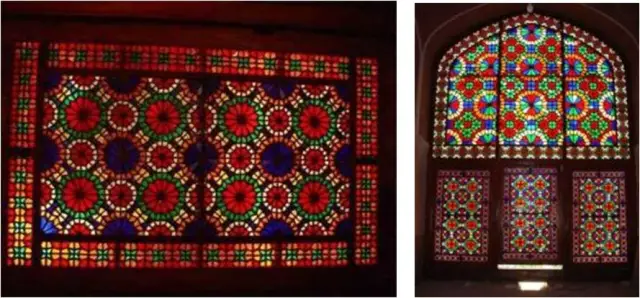
- The Northeast portion consists of a saloon with pillars between two rooms.
- Access to these rooms is made through the saloon.
- The saloon is having such arrangements, which make the yard look beautiful.
- A wind Catcher is also erected at the southern corner of this portion.
- At the South-West portion there are only few curved structures just to maintain balance with the structures made inside the yard.
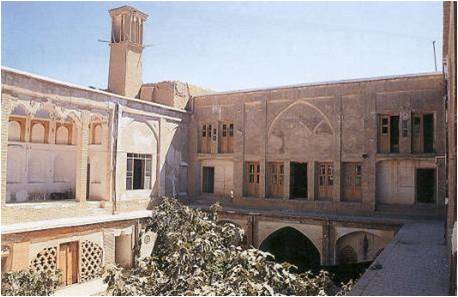
- Access to four sides of the garden is made through the yard.
- Yard forms the main part of a Yazdi house.
- A huge central water pool and resistance trees such as pomegranate, grapes, pistachio and keep the atmosphere moister and calm making the space beautiful.
- Yard in a Yazdi house is also a place for variety of children games.
- During summer, the grapes trees over the passage act as an umbrella to prevent the sunlight from entering into the residential spaces while in winter, their leafless brunches conduct the same into rooms.
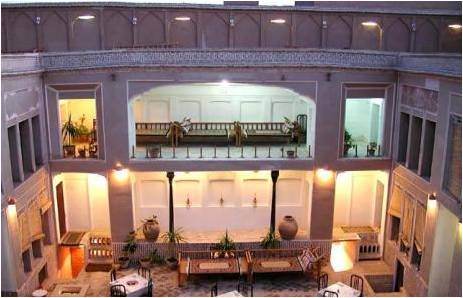
- There had been two water cellars in the yard, one at the South – East and other at the North-West portion, at a lower level compared to the level of the yard with stairs connecting them directly to the yard.
- The South-East cellar is made of saloon-like and enter connected spaces.
- A tall wing catcher behind the opposite portion circulates air through the cellar at this portion.
- Basement was used in summers as a living place or to store foodstuff.
- The house has been designed in such a way that its wind catcher of the yard and trench of the garden provide a peaceful and pleasure atmosphere during the hot summer of the region.
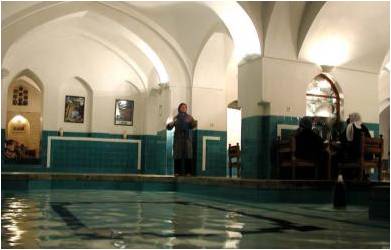
LAYOUT PLANS:
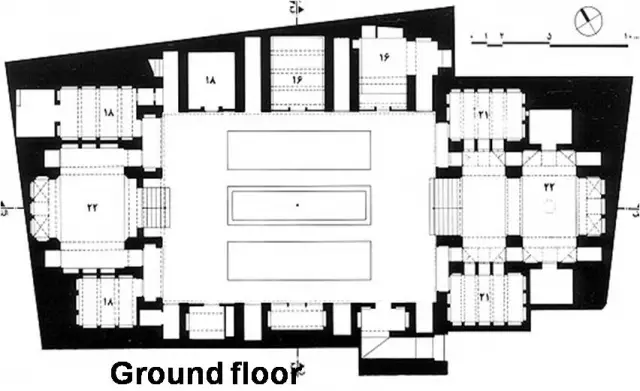
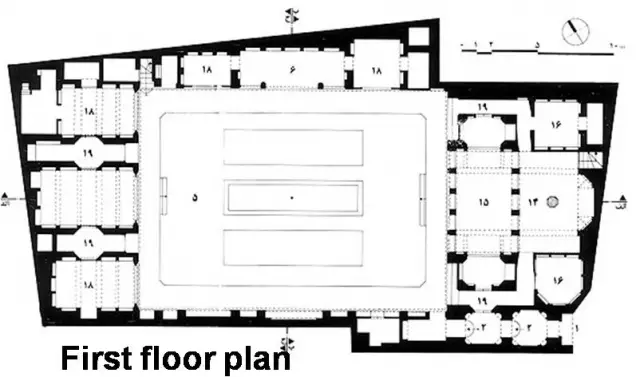
BUILDING MATERIALS
- Every building material in this desert town is composed of mud and unbaked brick.
- In fact nothing but mud and mortar can be used in such region because there are no other building materials.
- In fact they used all the earth excavated housing construction as building material.
- The mud and unbaked brick are the perfect resistance.
- In the cold season the absorbed temperature serve as an insulation which protect the inside air from being effected by the chilly winter desert climate.
- During hot season the absorbed temperature, mud and un backed bricks strongly resist the incessant sun rays.
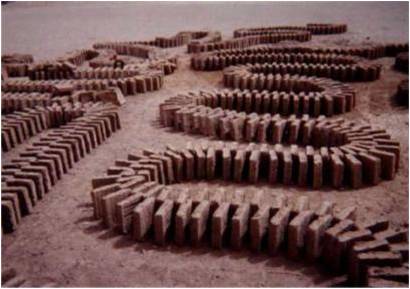
Khesht (Sun Dried Bricks) at Naren Rampart’s Restoration
WIND CATCHERS, COOLING SYSTEM
- Wind towers catch the passive winds and channel them down to the ground and basement living spaces.
- They not only cool the occupants on summer mornings, evenings when the air is cooler than room air, but they also provide ventilation to refresh the air and remove un wanted smells from cooking, bodies and other materials.
- Specially in the basement at night when the air is cool it passes over the walls and roofs and ceiling, drawing the stored heat of the day from them and so when the family enters them in the morning they are cool to sit in.
- Sometimes in the very hot summer nights family climb up to the roof and they sleep under stars.
- The whole form of the house is designed to maximize its passive cooling potential in summer and its power to warm in winter.
- The materials (used in building) are brilliant not only at absorbing and storing heat or coolness but also as insulation so once the heat or coolness are in, they stay there.
IN BRIEF
- In the heart of the Central Iranian desert is the ancient city of Yazd.
- Its builders were and are remarkable for their ability to create domes and vaults of mud and baked brick over rooms as wide as 6 meters.
- In the scorching hot and dry summers the inhabitants spend their afternoons, cool in the deep basements and many rooms and courtyards of their houses with rich gardens, ponds and fountains.
- The great open vaulted summer rooms face north across the courtyard, away from the sun, while the winter rooms with their glass doors, face south towards the low winter sun.
- At night in summer, in the old houses of Yazd, families climb onto the roof and sleep beneath the stars, under warm quilts to protect them from the cold night sky while the cool night winds circulate through the open doors and wind catchers drawing the heat of the days from the great mud walls of the house.
- In winter the family retreats to live on the courtyard level only, spending most of the day and night in winter living rooms. In these the glass and timber doors catch the free heat of the sun, to be stored again the in the great brick walls, often 70-80 cms wide to keep the family warm at night.
- Yazd is called in Iran, ‘the City of Wind catchers’ and one can see why, even as one approaches from a distance.
- High above the roofs of the city rise the great wind towers that catch the passing winds and channel them down to the ground and basement living spaces.
- Here they not only cool the occupants on summer mornings and evenings when the air is cooler than room air, but they also provide ventilation to refresh the air and remove unwanted smells from cooking, bodies and other materials, especially in the basements.
- At night, when the air is cool, it passes over the walls and floors and ceiling, drawing the stored heat of the day from them and so when the family enters them in the morning they are cool to sit in.
- The whole form of the house is designed to maximize its passive cooling potential in summer and its power to warm in winter, when sun angles have to be designed well to ensure the maximum penetration of the sun into the winter room.
- The materials of which the houses were traditionally built were mud brick, some baked brick, some white lime plastered walls and baked floor tiles.
- The materials are brilliant not only at absorbing and storing heat and coolth but also as insulators, so once the heat or coolth are in, they stay there.
- In addition the designers used the massive form of the building , with rubble filled spaces in walls and roofs, hypocausts, made of partially filled cavities, and shade walls and roofs to not only ensure that the sun never fell on, for instance, a thinner part of the roof, or inside rooms in summer with angled walls, but also they used the curve of the domes and vaults to minimize solar gain into the room below and speed up heat loss from the room through ventilated cupolas, or HAWA KESH.
- In modern Yazdi houses much of this has changed and they are typically built of rooms around a central ‘hall’ that is in effect a year round living room for the family.
- This hall often has a higher ceiling than the adjacent ‘buffer’ rooms against the sun, with carefully positioned clerestory windows that can be used to remove the hot air from the room below as it rises.
- These rooms are often air-conditioned today but still use a real Yazdi feature with is the north facing AIVAN, or raised veranda (usually c.600-800cms) above the courtyard, on which the family spread their rich carpets and sit enjoying the morning and evening breezes in the shaded part of the courtyard.
- The rooms around the hall include bedrooms, kitchen, bathrooms, storage rooms and the formal sitting room for guests with the separate entrance from the front garden to ensure privacy for the women.

thanks. the article is nice
thanks. the article is nice and perfect.